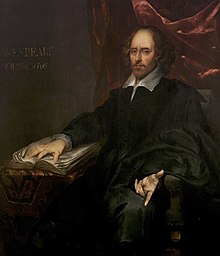Pieter Borselaer
Pieter Borselaer , also Pieter Borsseler , (* around 1640 in Middelburg ; † after 1717) was a Dutch portrait painter who worked mainly in Great Britain in the second half of the 17th century.
biography
Pieter Borselaer comes from the long -established noble or patrician family Borselaer (later spelling: Bostelaar ) from Middelburg. His parents were Cornelis Pieters Borselaer (born December 26, 1619) and Catelijntje Cornelis. Between 1651 and 1654 he stayed in Antwerp as a student of Thomas Willeboirts Bosschaert . It is documented that Borselaer was in England in 1665. Up until 1679 he mainly painted portraits of English nobles there. One example is the Chesterfield portrait by William Shakespeare from around 1668 , which is attributed to Borselaer. The model for the posthumous work was probably the Chandos portrait .
A stay in The Hague is documented for the years 1681 to 1684 , but there is no knowledge of artistic activities. Around 1684, Borselaer is back in his native town of Middelburg, where he probably lived until his death. In 1717 there is an entry of his name in the "Privilegieboek" of the St. Lucasgilde in Middelburg with the family coat of arms. This gives us a term post quem for the date of his death. No other activities are known.
Pieter Borselaer's earliest known work is dated 1664; he achieved his breakthrough with the portrait of William Dugdale from 1665 . Other works by Borselaer are the portraits of Orlando Bridgman and of the Hoby family ( Bisham Abbey ); by Lady Mary Bruce , Queen Catherine of Braganza and Samuel Butler ( National Portrait Gallery , London); by Admiral Cornelis Tromp and the portrait of an English widow ( Rijksmuseum Amsterdam ). He was known for his melancholy style and sober character.
literature
- Tarnya Cooper: Searching for Shakespeare. Yale University Press, p. 70.
- Stanley Wells: A Dictionary of Shakespeare. Oxford University Press, 2005, p. 28.
Web links
| personal data | |
|---|---|
| SURNAME | Borselaer, Pieter |
| ALTERNATIVE NAMES | Borsseler, Pieter |
| BRIEF DESCRIPTION | Dutch painter |
| DATE OF BIRTH | around 1640 |
| PLACE OF BIRTH | Middelburg |
| DATE OF DEATH | around 1717 |
| Place of death | Middelburg |

